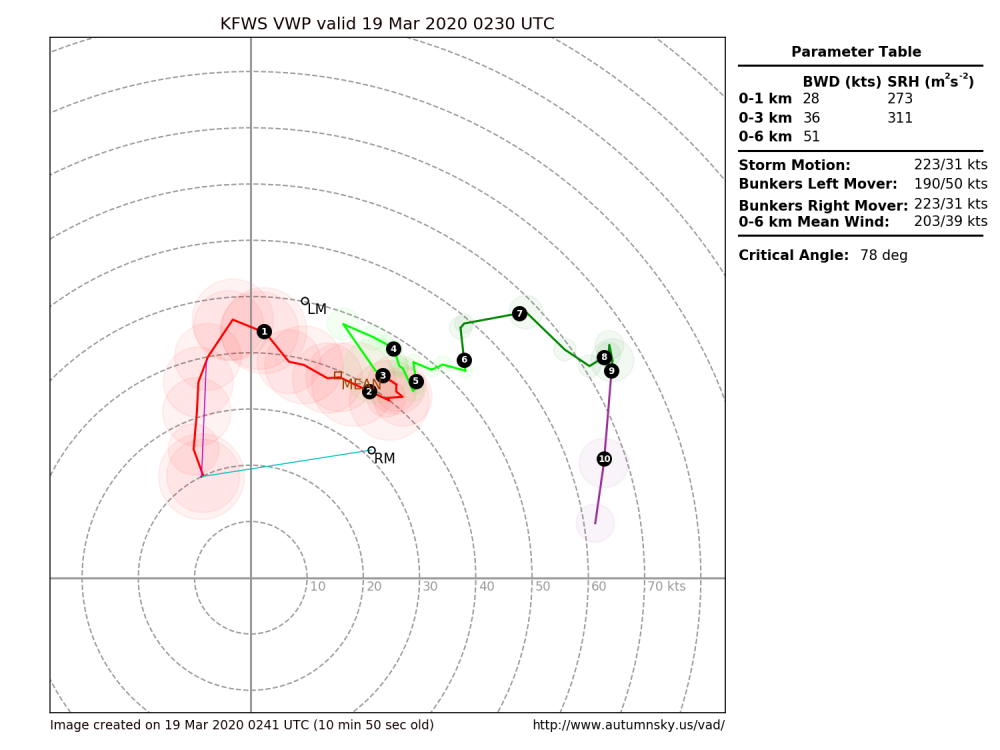-
Posts
1,004 -
Joined
-
Last visited
Content Type
Profiles
Blogs
Forums
American Weather
Media Demo
Store
Gallery
Everything posted by 1900hurricane
-

Easter Weekend Severe Thread
1900hurricane replied to janetjanet998's topic in Central/Western States
Oof, that's a stout watch. -

Easter Weekend Severe Thread
1900hurricane replied to janetjanet998's topic in Central/Western States
Main event might actually start a little bit later. Mesoscale Discussion 0339 NWS Storm Prediction Center Norman OK 0751 PM CDT Sat Apr 11 2020 Areas affected...The Edwards Plateau area of Texas and adjacent Rio Grande Valley Concerning...Severe potential...Watch possible Valid 120051Z - 120215Z Probability of Watch Issuance...40 percent SUMMARY...Severe risk is forecast to increase with time across the Edwards Plateau and vicinity. Large hail should be the main risk, though potential for locally damaging winds a possibly a tornado or two will also exist. DISCUSSION...Latest radar loop shows a persistent storm just to the Mexican side of the Rio Grande west of Del Rio, which has intensified over the past half hour. High-res CAM output continues to suggest that an isolated storm or two may cross the River into the Val Verde/Edwards/Kinney County vicinity this evening, consistent with the evolution of this cell. Other congested cumulus over the Mexican higher terrain has remained steady-state, with some signs of decrease recently, in conjunction with diurnal cooling. However, as ascent with the approaching southern AZ upper low continues advancing eastward, a later, more widespread increase in storms is expected across southwestern Texas. A consistent signal persists in CAM output that rather rapid, widespread convective development -- separate from the current storm -- will occur, within the 04Z to 06Z time frame. The expected, isolated nature of the current convection may permit delay in WW issuance in the short term. Potential for watch issuance will increase later this evening however, as the aforementioned UVV spreads eastward toward this region. ..Goss/Hart.. 04/12/2020 ...Please see www.spc.noaa.gov for graphic product... ATTN...WFO...EWX...SJT...MAF... LAT...LON 29470169 30110178 30450141 30570027 30459989 29949951 29359973 28920054 29470169 -

Easter Weekend Severe Thread
1900hurricane replied to janetjanet998's topic in Central/Western States
That was the northern unhatched 10% region. The southern hatched 10% region still remains from Del Rio to Austin. -

Easter Weekend Severe Thread
1900hurricane replied to janetjanet998's topic in Central/Western States
Warning is hoisted now. Big TBSS on it already. -
Here's a Twitter post that maybe gives us a glance into the current thoughts of SPC forecasters.
-

Easter Weekend Severe Thread
1900hurricane replied to janetjanet998's topic in Central/Western States
I'm starting to get a little more interested in the Del Rio to College Station corridor in the overnight period. As is typical with an overnight threat, low level lapse rates are not great and there is some capping involved. However, I do wonder if the combination of a lead shortwave and the ejection of the main trough might erode capping enough to get true surface based convection. I'm not usually too keen on overnight storms rooting to the surface in this region because of nocturnal decoupling in the boundary layer, but this may one of those times it has a better shot at happening. In any case, the SPC does have a 10% hatched risk from Del Rio to Austin for the overnight and mentions all modes of severe weather are possible. -
At the risk of sounding like a total nutjob, what if the very high 0-1 km SRH in the lesser outcome models is a sign of a poorly mixed boundary layer where the surface remains largely uncoupled from the low level jet? It seems counterintuitive, but if the low level jet and surface aren't coupled, surface winds would be lower and 0-1 km SRH would increase. The ARW/NSSL WRFs from 00Z all show low level winds closer in vector to the low level jet than the 3km NAM and NMMB of the same suite, which have weaker winds with a stronger easterly component. That however leaves the question of why the boundary layer wouldn't be mixing. Maybe low level lapse rates have something to do with it. It's a highly anecdotal case, but January 10th, 2020 was a day that had a very strong low level jet, massive 0-1 km SRH, enough instability at face value, but poor low level lapse rates across Texas (sounding below). Storms were largely elevated and messy that day. Again, highly anecdotal and far from anything scientifically sound, but maybe something to watch.
-
As a reference point, here is the 12Z sounding from JAN on April 24, 2010 with a modified surface temperature of 78ºF to match conditions for the Yazoo City tornado (original unmodified here).
-

Severe Weather March 15-19
1900hurricane replied to Sydney Claridge's topic in Central/Western States
I suspect the anvil rain from the upstream storms is keeping that lead cell from going off more than it already has. -

Severe Weather March 15-19
1900hurricane replied to Sydney Claridge's topic in Central/Western States
Strong couplet back east of Graham too. -

Severe Weather March 15-19
1900hurricane replied to Sydney Claridge's topic in Central/Western States
-
Typhoon Faxai looks like it could be the rare typhoon to make landfall on Honshu as a fully tropical (not transitioning) system in the next 24 hours. Worse, it could hit the Tokyo Bay/Kanto Plain area head on.
-

Central/Western Medium-Long Range Discussion
1900hurricane replied to andyhb's topic in Central/Western States
I figure this is relevant. https://twitter.com/ahberrington/status/1107346133276413952 -

Central/Western Medium-Long Range Discussion
1900hurricane replied to andyhb's topic in Central/Western States
It's only early March, and we just had a big cold intrusion push all the way through the southern plains and into the gulf, but the overall background state appears to be becoming more favorable for severe weather. Guidance has two rather potent shortwave troughs ejecting into the plains over the next ten days with at least some chances of severe weather for the region, with the first one already having a thread up. -
After one of the quietest starts to date, the WPac has woken up in a big way. Six tropical cyclones or invests currently are spread through the basin.
-
Slow start for the WPac this year, although that has been fairly typical these past few years.
-

Central/Western Medium-Long Range Discussion
1900hurricane replied to andyhb's topic in Central/Western States
The failure mode I'm worried about most right now for next week is 2015 style MCSs prematurely clearing out the warm sector actually. It might be a little early to be overly concerned about it, but guidance is throwing some persistent and robust splitting upper level jets over the southern plains, which is driving the QPF fields way up. -

Central/Western Medium-Long Range Discussion
1900hurricane replied to andyhb's topic in Central/Western States
I went ahead and pulled the trigger in setting aside most of next week for chasing. I've never dedicated this big of a time block to chasing in the past, so I'm really excited to finally be able to do something like this. The persistent western troughing progged across all guidance helped solidify it in my mind. -

Central/Western Medium-Long Range Discussion
1900hurricane replied to andyhb's topic in Central/Western States
Yeah, I'm wary to buy into the recent GFS solutions for next Wednesday, especially with the depicted trough being so different from not just the other solutions, but its own ensemble mean as well. Very few individual ensemble members support the operational solution, so it's not likely the mean is becoming too washed out from dispersance either. That's not to say that it can't be a good severe weather day, but I have my doubts that the last few operational GFS solutions will verify the best for the possible event. One day that I may begin to keep an eye on is the following Friday, April 21st. It's about 200 hours out as we stand right now, and anything this far out is a far cry from a guarantee as everyone pretty much knows, but the GEFS, GEPS, and EPS means all show troughs ejecting into the southern plains in this time period.




.gif.eece07a8877f4daa06bd505d0a7f9eb0.gif)